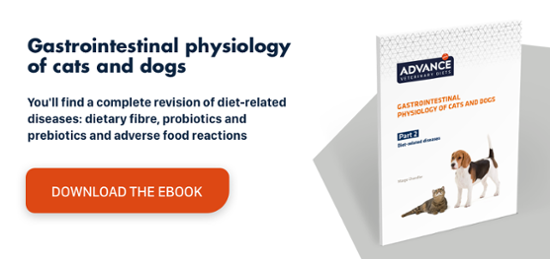Cardiogenic pulmonary oedema in cats: radiographic appearance
Cardiogenic pulmonary oedema in cats is the result of increased alveolar capillary pressure within the context of heart failure. Heart failure is a condition with a broad spectrum of clinical signs as the mechanism causing the heart failure may lie in various different structures and areas of the heart.
This damage causes changes in the blood pressure and blood transport capacity that vary depending on which cardiac structure is affected; consequently, this translates into different clinical signs that can be used to make a symptomatic diagnosis that hones in on the location of the cardiac lesion.
Cardiac insufficiency is divided into anterograde and retrograde heart failure. The retrograde form is also called congestive heart failure. The anterograde form is characterised by a decrease in cardiac output and subsequently impaired tissue perfusion of the vital organs, causing cerebral and renal dysfunction. On the other hand, congestive heart failure is defined by an increase in ventricular end diastolic pressure that in turn elevates atrial pressure and hence pulmonary and systemic arterial pressure causing cardiogenic pulmonary oedema and ascites. Cardiac lesions (to the valves or myocardium) can cause either type of heart failure, although they usually cause a combination of both, with pulmonary and systemic signs or only one set of signs depending on the location of the lesion. Sound knowledge of the pathophysiology is essential to appreciate both the cause and consequences of heart failure.
The diagnosis of heart failure is based on the clinical signs, the radiographic signs and plasma natriuretic peptide levels, but there is no single diagnostic test that can confirm the diagnosis of heart failure. Thus, an accurate diagnosis depends on the vet’s familiarity with the radiographic signs that tend to be revealed by a chest X-ray.
A chest X-ray is a noninvasive method of observing the state of the pulmonary veins and determining whether any respiratory symptoms are secondary to pulmonary oedema or other processes (pneumonia). While the radiographic image of cardiogenic oedema is well defined in dogs1 (symmetrical bilateral alveolar pattern that is more marked in the caudodorsal region), the radiographic pattern in cats has always been considered more erratic. The typical radiographic signs in cats are patchy or localised infiltrates forming a highly variable pattern throughout the lung.
Furthermore, heart failure can produce pleural effusion (which is more frequent in cats than dogs), which increases the difficulty of making a radiographic diagnosis.
Not many publications discuss the relationship between heart failure in cats and the radiographic signs that can be used to characterise the appearance of cardiogenic oedema more accurately in chest X-rays. Here we discuss a study conducted in 2009 by hospitals in the UK and Australia that sought to identify the radiographic signs of cardiogenic oedema in cats diagnosed with heart failure.
The authors searched for cases of cats with an echocardiogram-based diagnosis of heart failure due to myocardial disease who also underwent a chest X-ray during the same hospital stay. Cats with only one chest X-ray projection and those with a normal chest X-ray were excluded from the study. Pulmonary opacities were classified as bronchial, vascular, interstitial or alveolar. After classifying the opacities, the extension of the lesions was classed as diffuse if they included the whole lung or local/multifocal if there were unaffected areas of the lung fields. Diffuse opacities were subclassified as having either a uniform or nonuniform distribution.
Finally, the study included 23 cats that met the criteria. All cats had respiratory signs when admitted to hospital. Ninety-one percent had tachypnea and 70% had dyspnoea. The mean respiratory rate was 60 breaths per minute and the mean heart rate 204 bpm. Eight cats had a systolic murmur, five had gallop sounds and two presented arrhythmia. All subjects had left atrial enlargement. Most cats (87%) showed an improvement in respiratory signs after treatment with furosemide. All subjects that did not respond to furosemide died shortly after the diagnosis of heart failure.
The radiographic appearance of the lungs was characterised by opacities of variable patterns and distributions. All cats showed evidence of an interstitial or granular pattern that reduced the clarity of the margins of the pulmonary vessels and the cardiac silhouette. In 83% of the subjects, this pattern was associated with an alveolar pattern and in some cases with an air bronchogram. In 70% of the sample, the perivascular interstitial pattern was associated with an increase in pulmonary vessel diameter. The predominant pattern seen in most cats was an alveolar pattern. As for the distribution of the opacities, most were uniformly diffuse, followed in descending order of frequency by nonuniform diffuse, multifocal and lastly single focal opacities. None of the cats showed signs of unilateral lung compromise and bilateral affectation was almost always observed.
A Uniform, diffuse pulmonary oedema with interstitial pattern and thickening of the pulmonary vessels.
B Nonuniform, diffuse pulmonary oedema with alveolar pattern.
In conclusion, it is surprising that a condition as prevalent as cardiogenic oedema in cats has received such limited radiographic research attention. After reviewing the study, we can conclude that cardiogenic pulmonary oedema has a variable radiographic appearance, which is why vets managing this disease must be familiar with its multiple patterns to ensure they reach the correct diagnosis.


